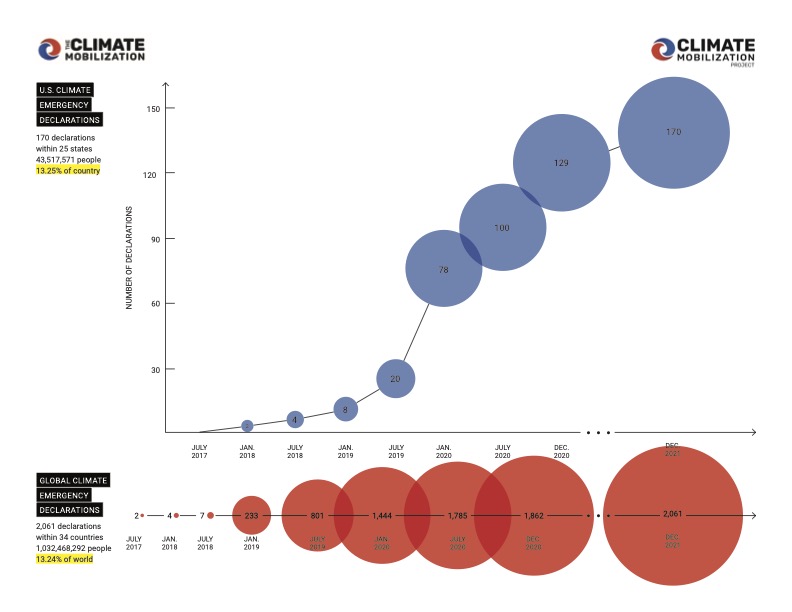This is a repost of a recent Resilience article from TCM allies Larry Edwards and Stan Cox on “Cap and Adapt” — a national policy proposal towards the managed decline of fossil fuels.
By Larry Edwards and Stan Cox
The utter peril that the United States and all of humanity now face from global climate change is evident to anyone paying attention. The succession of extraordinary climate catastrophes over recent years is continual, increasing and widespread. Extreme weather events are becoming more intense and more frequent to the point that many regions now suffer back-to-back and even concurrent disasters. Emergency response capacity is being stretched increasingly thin, recoveries are prolonged, and migration from climate-impacted areas are already occurring.
Awareness that climate change is the world’s highest-order emergency is growing. Nearly 1,000 governments worldwide – including a few national ones – have made formal climate emergency declarations. Mass demonstrations worldwide by millions of young people and new activist groups like Extinction Rebellion are elevating the climate emergency to the top of the public agenda. In the United States, climate change tops the list of issues that the American public wants Democratic presidential candidates to debate onstage, and some candidates have proposed strong climate programs of a new kind.
In Congress this July, a concurrent resolution for the United States to declare a climate emergency was introduced by Senator Bernie Sanders, Representative Earl Blumenauer, and Representative Alexandria Ocasio-Cortez, and has sixty-eight cosponsors. Among them are all the senators who are major Democratic Presidential candidates.
This national climate emergency resolution “demands a massive-scale mobilization to halt, reverse, and address its consequences and causes.” It states that this requires “a managed phase out of the use of oil, gas, and coal to keep fossil fuels in the ground.” While the resolution addresses the need to control all greenhouse gases, its concept of a managed phase out of fossil fuels goes directly to the root of the largest U.S. contribution to climate breakdown. Seventy-six percent of U.S. greenhouse gas emissions are from fossil fuel combustion.
Here, we propose a policy framework we call Cap and Adapt, to accomplish the resolution’s proposed managed phase out of fossil fuels, and by design to do so at a speed matching the last-minutes-to-midnight urgency of our climate plight. Also, by design, it is inherently failsafe[1] both for meeting any target end-date the final legislation may adopt for the phase out and for ensuring the needs of individuals, families, communities, and the national economy are met.
Let’s “lead the target,” to achieve utmost climate policy
Before the 2020 election, the nation will ride through one more winter and one more summer of blizzards, heatwaves, ice storms, wildfires, hurricanes and floods. If the more frequent and intense climate-amplified catastrophes of recent years and so far this year are a guide, by the time we vote, American’s climate angst will be much higher and we may get a very climate-activated Congress. And before the new Congress takes office and (hopefully) a new President is sworn in, there will be yet another winter of climate impacts to further prompt strong legislation.
Activists should anticipate a major shift in the American public’s mindset and the political scene by the time the 2021 legislative season commences. It is crucial to have ready, for congressional progressives to introduce, a full-strength draft bill that decisively tackles the fossil fuels problem, with a phase-out schedule of utmost speed and including a social and economic safety net. We suggest Cap and Adapt.
Cap and Adapt – A failsafe climate policy for fossil fuels
The principles behind the Cap and Adapt policy framework are
-
to be fast-acting and inherently failsafe for delivering essentially[2] zero fossil fuel emissions, by whatever end-date a finally legislated policy might require, and;
-
to be fair, equitable and inherently failsafe in meeting the needs of the economy, regions, communities, families and individuals.
The framework itself has three parts, whose justifications and functions we’ll explain later. The first is a cap on fossil fuel extraction and imports that declines on a fixed schedule prescribed in the legislation. The cap has primacy in the framework, because stabilizing (and then reversing) the climate crisis must have primacy in public policy. The other two parts, which help society and the economy adapt to that declining supply of fossil fuels, are an enhanced Green New Deal to facilitate the just and complete transition of the US economy to 100% renewable energy, and a standby program to smoothly and fairly ration national fossil fuel supplies in the event of energy shortages during the transition.
How fast can Cap and Adapt go in eliminating fossil fuels? We propose a ten-year end-date, attaining essentially zero fossil fuel use in the United States by April 28, 2031. That is exactly ten years after the 100th day in office of the president who will be sworn in on January 20, 2021. The extraction and import of each kind of fossil fuel and the embedded emissions in imports decline to near-nil in ten equal, annual steps. Each annual step is 10% of the quantity of fuels extracted and of the carbon content of goods imported in a 2020 base year. However, our Cap and Adapt will work for any target end-date that becomes established in legislation or by executive order. Ours is an emergency-based proposal, in contrast to carbon budget-based target dates in other policy proposals that are premised on keeping temperature rise below the arbitrary, very unsafe 1.5°C or 2°C levels. Those proposals typically have net-zero emissions dates of 2045, 2050 or beyond.
We acknowledge that the Cap and Adapt proposal sets a high, politically difficult-to-clear bar. But in the face of the deepening climate emergency, bold policy that leads the target for legislative potential and helps move the goalposts is vital. Weaker policy on fossil fuels or their emissions, if adopted, will fail us. Cap and Adapt starts at the top of the fossil fuel supply chain, where regulation is effective, easy to accomplish, and can be failsafe for cutting emissions.
Here are Cap and Adapt’s three parts.
-
The Cap.
This top level of the framework implements the congressional emergency resolution’s call for “a managed phase-out of the use of oil, gas and coal.” It puts a linearly[3] declining cap[4] on the extraction and imports of those fossil fuels that will reach essentially zero before a specified end-date. Each year until then, fossil fuel extractors and importers (“producers”) will be issued free, non-tradeable permits for specific quantities of the raw or imported fuels each is allowed to produce.[5]
The end-date will be specified in the legislation, and should be aggressive. The cap’s linear rate of decline is identical for overall fossil fuel production and each kind of fuel, and automatically so for CO2 emissions. The rate of decline can be calculated from the initial number of years until the end-date. For each kind of fuel, the annual decline and the permitted production are measured in units of volume or weight, is the same every year, and is calculated based on production in the year before the program’s initiation. The rate of decline is incumbent on each producer[6] for each of its kinds of extracted or imported supply, and is enforced through the annually issued permits.
By its nature, the declining cap is failsafe for meeting the end-date target because it directly reduces the production of carbon that would be emitted as CO2, it uses a rigid predetermined schedule, and it is enforceable through permits. An aggressive cap will send a strong signal that new fossil fuel-consuming infrastructure should not be built and that existing infrastructure will soon have to be retired, much of it before its normal end of life. Recent research shows that early retirement is necessary, even for less stringent policies than Cap and Adapt.
To avoid inflation, the permits will be issued at no cost (other than perhaps a fee to cover the program’s administration expenses). A price on permits is unnecessary for controlling emissions because the declining cap does that, fully. Price controls can be utilized if necessary to keep prices reasonable and prevent profiteering on free permits and the cap’s induced scarcity.
Capping the carbon embedded in imported goods
Importation of fuels and goods is a pathway for some CO2 emissions to “leak” around the domestic cap on fuels extraction, in the form of emissions from manufacturing and transport that essentially become embedded in those products before they reach the port of entry. Any leakage disadvantages domestic manufacturers who are affected by the domestic cap and also undercuts the nation’s emissions reductions. Leakage can be reduced or eliminated with border carbon adjustments (BCAs). These must be designed to comply with requirements of international trade treaties, principally the General Agreement on Tariffs and Trade (GATT).[7]Boundary adjustments can either be quantity-based or price-based.
The Cap and Adapt framework incorporates two kinds of quantity-based BCAs. Capping the importation of fossils fuels is straightforward, since it will be done on the same schedule and by the same means as with domestic fuel producers, but at a port of entry instead of a well or mine. Putting a declining cap on CO2 emissions that are embedded in imported goods during their production is different, because the capping occurs far down the supply chain, thereby accounting for emissions made long before the port of entry is reached. Involved are emissions from the production processes of a multitude of products and services, often involving several industries, transportation links, and middlemen. However, this accounting can be done because multiregional databases exist for determining embedded carbon and CO2 emissions.
-
Mobilization – Adapting to the phase-out
A nationwide mobilization of industry, the economy and the workforce is a necessary part of the program to eliminate America’s fossil fuel emissions, as envisioned in the Green New Deal resolution and the climate emergency resolution. The purpose is to supplant fossil energy through the construction of a 100% renewable energy supply and the necessary electricity distribution networks and by making energy efficiency and conservation improvements.[8]The cap necessitates an enhancement to the Green New Deal to distribute to the economy’s sectors, in a way best meeting the needs of the populace, the diminishing supplies of fossil fuels and those imported goods that have embedded emissions. A particularly important one of those sectors is the Green New Deal mobilization itself, so the energy transition can be completed on schedule. This supply-side allocation mechanism operates without putting a price on carbon or fuels; we’ll discuss it later.
While the Green New Deal has not yet been fleshed out in a detailed proposal to Congress, we rely here on its spirit as expressed in HR109/SR59 and its intent for a rapid mobilization. We also foresee the Green New Deal repurposing some economic sectors to meet the needs of the transition, as was done during World War II. Importantly, Green New Deal policies will also ensure that no one will be left behind in the transition, and that employment opportunities created by the transition from fossil fuels are open to all, including people from the replaced industries.
-
Standby rationing – Adapting if a shortage occurs
A ready-to-go rationing program is necessary in case renewable energy capacity,[9] its supporting infrastructure (e.g., the expanded electric grid), and energy efficiency improvements can’t be put in place fast enough to fully substitute for the cap-enforced decline in fossil fuels. This rationing of fossil fuels will be by quantity (volume or weight of the fuel), instead of by price as is the case today. If rationing is triggered, ways to alleviate it must be sought that don’t impede the cap’s schedule.
Some technology advocates believe expansion of renewable energy, energy efficiency improvements and demand reduction alone can completely displace and substitute for fossil energy in time to prevent climatic disaster. Essentially, it is a belief that a Green New Deal will be sufficient by itself. If it turns out they are right, rationing won’t be triggered. In that case, having the rationing program on standby and ready to go will have served as an important insurance policy.
But if not, rationing will be vital safety-net for society, national security, and achieving the necessary climate target. By its nature, if rationing is triggered it principally will affect those who have big carbon footprints (generally the wealthy).
Fuel rationing as reasonable climate emergency policy
The role of rationing, if shortages arise, will be to ensure fair distribution of available fuels and electricity to households and other end users, satisfy the basic personal needs of all, and avoid the chaotic ad hoc rationing-by-queuing iconified by the 1970s oil crisis. This fair-shares rationing system will issue personal allowances for purchases of fuels and major fuel-using transport services (e.g. air travel). If rationing is triggered, ways to alleviate it must be sought that don’t impede the cap’s schedule.
Rationing is a policy of last resort, but one that gains popular appeal under dire circumstances, if certain conditions coexist: that it is shown to be necessary; that it will be effective in itself and in addressing a larger overarching problem; that it will apply to everyone; that it will be fairly administered; and that vigorous enforcement will make violators few. This cause for acceptance, and success, has been demonstrated over and over both historically and in contemporary societies worldwide, and most famously in the U.K. and U.S. during World War II.
Some have called for using fossil fuel rationing as a means for reducing CO2 emissions, but that requires rationing to be in use constantly. Instead, in Cap and Adapt the cap performs the emissions-reduction role, enabling rationing to be purely a standby precaution that makes sure this climate-failsafe policy is also socially failsafe. Ending fossil fuel use is requisite; rationing – if ever needed – is the last of two mechanisms for adapting the nation to that need.
Rationing allowances will be in units of volume or weight of fuel, not dollars or relative carbon content. Individuals will have rationing smart-cards, automatically credited with fresh allowances every week, and then debited when making purchases. Detailed systems for this kind of rationing have been developed but would need to be adjusted for the current situation. See, for example, the concept of transferable energy quotas (TEQs), which the U.K. Parliament considered over a decade ago. It was rejected then as being ahead of its time, but with the now-recognized emergency, such an approach is timely and urgently needed.[10]Several kinds of rationing systems are possible, and any could be used in our climate policy framework. Personal allowances can be either tradeable or non-tradeable, and if they are tradeable that could be through personal sales or via an equitable non-price means. Our belief is that precluding the pricing or sale of allowances but providing a system for equitable access to a pool of unused allowances will make the system fairer and better functioning.
Institutionalizing the framework’s two adaptation features
The successful national mobilization during World War II is a model for today. It was necessary, for supporting the U.S. economy and society while pursuing the overwhelming task at hand, for making sweeping changes in public institutions and policies, as well as making macro-scale government interventions in the economy. The War Production Board, for example, managed the allocation of resources among the military, industrial and civilian sectors, while the Office of Price Administration oversaw price controls and consumer rationing, for which the day-to-day mechanics were handled by local rationing boards attuned to local needs. Pricing was not used to make any of these allocations. The size of the bureaucracy required to administer all this was surprisingly modest; by the estimation of one economic historian it employed fewer people than the U.S. Post Office of the time.
Today, the nation’s urgent climate obligation requires a rapid, whole-economy transition from the use of harmful energy sources that are deeply embedded in the economy. An organization, The Climate Mobilization, has published a Victory Plan describing several agencies that, as in WWII, will be required to ensure sufficiency and fairness for all under our proposed cap. Cap and Adapt uses the same kind of non-price mechanism as before to allocate fossil fuels among the economy’s sectors, executed flexibly by a government agency to adapt to changing circumstances during the transition. The objective is to ensure the increasingly scarce fossil fuels are prioritized to the production and direct uses that are most needed by society and for the build-out of the transition to a fossil-fuel-free economy. Issuing fossil fuel allowances among the sectors[11] is a zero-sum game; because of the cap, an increased allocation to one economic sector means a lower allocation for other sectors. Allocation decisionmaking needs to include public consultation processes at the national, regional and community levels (including frontline communities) and consideration of not just of the economy and transition as wholes, but also the differing needs among regions and between seasons.
Just as with the cap’s free issuance of fossil fuel production permits, the allowances for fossil fuel use made to the economic sectors will also be free. This avoids inflation and keeps fuels affordable, until the time their production is eliminated. If price gouging begins to occur, price controls can be applied. Because of the cap on fossil fuel extraction, hypothetically controlling fuel prices at even a low level cannot increase their consumption or emissions.[12]Accordingly, employing price controls will not impair the rapid elimination of these fuels. (As well, any reason for using price vanishes as a means of reducing emissions, because emissions from fossil fuel use are completely controlled by the declining cap on fossil fuel production, and because the rapid buildup of renewable energy will hasten the transition away from dependence on fossil fuels.[13])
Similarly to the allocation of fuels, the permits for importation of emissions embedded in goods will be issued at no cost and the sectoral allocations will give priority to the needs of society and the energy transition. Here too, the no-cost permits will help avoid inflation, and also help prevent complaints under GATT that the free allocation of domestically-extracted fuels is a non-price barrier to trade. Besides contributing to reductions in the nation’s carbon footprint, the border carbon adjustment (BCA) involved in this serves a leadership function in encouraging exporting nations to shift to carbon-free production, an effect amplified by the fact that the cap declines rapidly to nearly nil.
Comparison to other policy approaches
Cap and Adapt vs. carbon pricing
Pricing strategies such as carbon fee and dividend, cap and trade, or polluter-pays taxation (which really means the customer pays) rely on indirect economic linkages, operate through time-wasting gradualism, and provide only incomplete emissions reductions. Because prices are a familiar feature of the economy, using them to try to control GHG emissions and to distribute fossil fuels within the economy seems natural to many people. It is increasingly apparent, however, that pricing is poison for climate policy, as indicated by the recent Yellow Vest movement in France and failures of two State of Washington voter initiatives. Several studies show that to be effective, the price on carbon would have to rise to hundreds or even thousands of dollars per ton. This is inflationary and pits everyone against everyone else, instead of fostering a sense of common purpose. Another difficulty with pricing is that ability to pay (with the wealthy having much more ability than others) influences the allocation of fuels to different uses (e.g. to jet fuel rather than gasoline) and to different sectors of production (e.g., favoring luxury goods over necessities). That has been tolerated in a time of unrestrained energy consumption, but it cannot be tolerated when available energy is limited. The systemic unfairness and counter-efficiency of pricing mechanisms is inherent and is a seed for malfunction or self-destruction of a policy that relies on them. In contrast, a policy focus on phasing-out the sources of carbon – directly keeping the devil in the ground – is simpler and more reliable than trying to reduce emissions indirectly by pricing carbon. And, history shows, it will spark far less resentment.
Although taxes on carbon or (directly) fossil fuels could help fund the energy transition, we are now too late in attacking climate change to rely on such partial, unreliable solutions for reducing emissions. The basis of a carbon or fuel tax declines under an effective climate policy as less fuel is used, with revenue reaching low levels just at the time when the higher, more expensive-to-reach mitigation “fruit” becomes crucial. Better funding options include taxes on wealth or high incomes, redirecting subsidies presently going to the fossil fuel industry, or using modern monetary theory (MMT).
Cap and Adapt vs. other “managed decline” proposals
Oil Change International and others propose a competing form of “managed decline” policy. It uses a prohibition on new development of fossil fuel deposits and further exploration, rather than using a hard-and-fast schedule for reduction in the flow of fuel. This approach is passive, implicitly setting the fossil fuel end-date to be when existing sources are depleted but not regulating sources that are already producing. Because of this limitation, it can’t achieve the aggressive end-dates that climate activists are increasingly demanding. Furthermore, the potential for a gap between the policy’s decline in fossil fuel extraction and the capability of a Green New Deal to adapt at all times to that decline is not addressed. The proposal isn’t failsafe for meeting an emissions target by any specific date, much less an aggressive date, or for protecting people in the event of possible fossil fuel shortages.
Conclusion
The Green New Deal resolution expresses hope but not certainty that its massive ten-year national mobilization will get the nation to net-zero emissions, since it has no provision for ensuring that performance. The House and Senate emergency resolution remedies that by recognizing that a managed phase-out of all fossil fuels is required. With respect to fossil fuel emissions, Cap and Adapt embodies those intents of the resolutions. It takes their concepts further, with a coordinated three-part framework designed to be failsafe for accomplishing the fossil fuel phase-out on an aggressive schedule, and to be failsafe for the needs of the economy and people in the event that a shortage develops.
Although a policy might be functionally failsafe due to its nature, no policy, once adopted, can be politically failsafe. Any effective policy will always be open to challenge. The best that can be done is to make the policy inherently fair, thereby providing some immunity from being weakened while still achieving its purpose. Cap and Adapt’s adaptive features provide fairness that helps defend against challenges to its cap. This is the best that any climate policy can do politically and still be highly effective.
A recent paper observed the need for emissions-cutting climate policy to use “both arms of the scissors,” meaning supply-side and demand-side approaches. Cap and Adapt does so. Its primary element is the supply-side cap on fossil fuel production and imports. It then uses two kinds of demand-side policies to adapt society and the economy to the cap, and provide a safety-net. We believe Cap and Adapt excels in its capabilities for speed and effectiveness, and is as failsafe in all respects as any climate policy can be.
[1] The term “failsafe” originated in the 1950s. It describes a system that is: surefire or can’t miss; “unlikely or unable to fail” (Oxford dictionary); “designed so that if one part of it does not work, the whole thing does not become dangerous” (Cambridge dictionary); and which “inherently responds in a way that will cause no or minimal harm … to the environment or people” (Wikipedia).
[2] There will be cause for some continuing production of fossil fuels at very low levels.
[3] Other ways to schedule the decline are possible, but this way is the most straight-forward and illustrative. Steeper decline rates in earlier years of the transition are more effective in limiting climate change harms.
[4] The cap is a regulatory upper limit on the amount of, in this case of Cap and Adapt, fuel extracted from the ground and the embedded emissions in imported goods.
[5] For domestic producers this applies at the well or mine. For importers it applies to the imported raw or finished fuel.
[6] Permit redistributions can be made in some fair manner if some producers exit the market over time.
[7] Among the relevant GATT principles a BCA must adhere to are evenhandedness, transparency, predictability and that the measure be for legitimate public policy reasons (e.g. conservation of an exhaustible resource, or protection of human, animal and plant life), and that it make a “material contribution” to its underlying purpose (in this case ratcheting down fossil fuel use, by preventing trade leakage).
[8] By combining the Green New Deal with the other two parts of the policy framework, we believe the “rebound effect” is eliminated. With fossil fuel increasingly restricted by the cap, the primary purpose for improving efficiency becomes stretching the utility of fossil fuels more so than saving costs. Even so, at the systemic scale the cap prevents aggregate cost savings made through energy efficiency from increasing the use of fossil fuels.
[9] This renewable energy may be thermal or electric.
[10] The TEQs approach is based on using market price for industrial allocation and personal trading of carbon quotas; however, Cap and Adapt proposes doing this without reliance on price.
[11] The set of sectors and subsectors in the allocation scheme can be as coarse or fine as necessary, and may change over time to meet changing circumstances. But the set must encompass the entire economy, including its governmental, military and civilian (including industrial, agricultural, transport, service, etc.) components.
[12] But fossil fuel prices should be maintained above the prices of renewable energy.
[13] Another Cap and Adapt driver of energy consumption away from fossil fuels is the cap’s transparent, definite schedule for rapid elimination of fossil fuels in the marketplace. It provides certainty for consumers, industry and financiers.
Teaser photo credit: By Ralf Roletschek – Own work, CC BY-SA 3.0 de

















